MaryAnn Bernal's Blog, page 240
September 11, 2014
History Trivia - Battle of Stirling Bridge - William Wallace and Andrew Moray defeat the English.
Sept 11

814 Louis I, the Pious, succeeded his father, the great French king Charlemagne, as King of the Franks and Emperor of the Romans.

1226 The Roman Catholic practice of public adoration of the Blessed Sacrament outside of Mass spread from monasteries to parishes.

1297 Battle of Stirling Bridge was a battle of the First War of Scottish Independence where the Scots jointly-led by William Wallace and Andrew Moray defeated the English.


814 Louis I, the Pious, succeeded his father, the great French king Charlemagne, as King of the Franks and Emperor of the Romans.

1226 The Roman Catholic practice of public adoration of the Blessed Sacrament outside of Mass spread from monasteries to parishes.

1297 Battle of Stirling Bridge was a battle of the First War of Scottish Independence where the Scots jointly-led by William Wallace and Andrew Moray defeated the English.

Published on September 11, 2014 05:42
September 10, 2014
The Briton and the Dane: Concordia featured on The Fussy Librarian
 HISTORICAL FICTION | FICTIONThe Briton and the Dane: Concordiaby Mary Ann Bernal
HISTORICAL FICTION | FICTIONThe Briton and the Dane: Concordiaby Mary Ann Bernal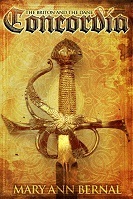 $0.99 Regular low price
$0.99 Regular low price BUY NOW
AmazonAVERAGE RATING 4.1 out of 16 reviews
AUDIOBOOK AVAILABLE? No
NUMBER OF PAGES 246
Concordia manipulates her besotted husband into taking her to Rome, but her ship is captured by bloodthirsty pirates, and the seafarers protecting her are ruthlessly slain to a man. As she awaits her fate in the Moorish captain’s bed, by sheer chance, she discovers that salvation is at hand in the gilded court of a Saracen nobleman. While awaiting rescue, Concordia finds herself at the center of intrigue, plots, blackmail, betrayal and the vain desires of two egotistical brothers, each willing to die for her favor. Using only feminine cunning, Concordia must defend her honor while plotting her escape as she awaits deliverance, somewhere inside steamy, unconquered Muslim Hispania.
The Fussy Librarian

Published on September 10, 2014 07:55
History Trivia - Empress Matilda dies
Sept 10

1167 Empress Matilda died. Daughter of King Henry I, widow of Holy Roman Emperor Henry V, and mother of King Henry II, Matilda (also known as Maud) engaged in a civil war with Stephen of Blois over the crown of England.

1419 John the Fearless, Duke of Burgundy was assassinated by adherents of the Dauphin, the future Charles VII of France.

1547 The Battle of Pinkie Cleugh, the last full scale military confrontation between England and Scotland, resulted in a decisive victory for the forces of Edward VI.


1167 Empress Matilda died. Daughter of King Henry I, widow of Holy Roman Emperor Henry V, and mother of King Henry II, Matilda (also known as Maud) engaged in a civil war with Stephen of Blois over the crown of England.

1419 John the Fearless, Duke of Burgundy was assassinated by adherents of the Dauphin, the future Charles VII of France.

1547 The Battle of Pinkie Cleugh, the last full scale military confrontation between England and Scotland, resulted in a decisive victory for the forces of Edward VI.

Published on September 10, 2014 05:59
September 9, 2014
Diane Turner - London Rocks - 09.09.2014
Published on September 09, 2014 05:51
History Trivia - Arminius' alliance of six Germanic tribes ambush and annihilates three Roman legions
Sept 9
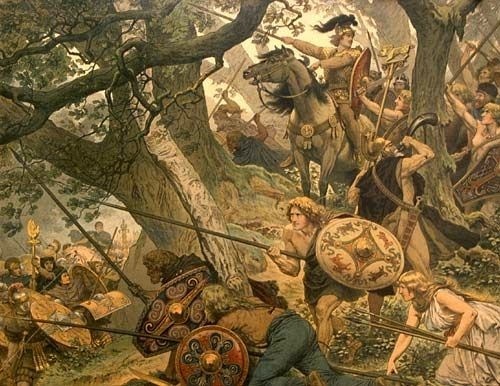
9 AD Arminius' alliance of six Germanic tribes ambushed and annihilated three Roman legions of Publius Quinctilius Varus in the Battle of the Teutoburg Forest.
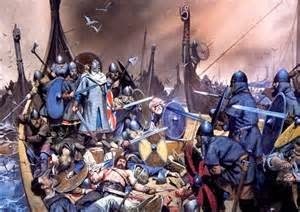
999 or 1000 Battle of Svolder was a naval battle fought in the western Baltic Sea between King Olaf Tryggvason of Norway and an alliance of his enemies; the background for this battle was the unification of Norway into a single state, long-standing Danish effort to gain control of the country, and the spread of Christianity in Scandinavia. With the allied victory, Norway was partitioned and the spread of Christianity was set back.

1087 William the Conqueror died in Rouen at age 59 after an accident while riding his horse.

1513 James IV of Scotland was defeated and died in the Battle of Flodden Field, ending Scotland's involvement in the War of the League of Cambrai.


9 AD Arminius' alliance of six Germanic tribes ambushed and annihilated three Roman legions of Publius Quinctilius Varus in the Battle of the Teutoburg Forest.

999 or 1000 Battle of Svolder was a naval battle fought in the western Baltic Sea between King Olaf Tryggvason of Norway and an alliance of his enemies; the background for this battle was the unification of Norway into a single state, long-standing Danish effort to gain control of the country, and the spread of Christianity in Scandinavia. With the allied victory, Norway was partitioned and the spread of Christianity was set back.

1087 William the Conqueror died in Rouen at age 59 after an accident while riding his horse.

1513 James IV of Scotland was defeated and died in the Battle of Flodden Field, ending Scotland's involvement in the War of the League of Cambrai.

Published on September 09, 2014 04:17
September 8, 2014
Tourists to gain access to excavations for hominid bones in South Africa
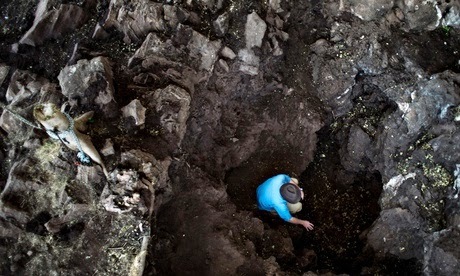
David Smith
Viewing platform and webcams at Cradle of Humankind site will allow visitors to look into pit during digs for early human fossils
Paleoanthropologist Prof Lee Berger, who discovered the Australopithecus sediba, peers into the Cradle Of Humankind site in South Africa. Photograph: Barcroft Media
With brio and a brown fedora that have earned comparisons with Indiana Jones, Professor Lee Berger leaps into a pit where he is hunting the remains of our ancestors who lived here 2 million years ago.
Typically such digs have taken place in remote corners of Africa, their discoveries announced in scientific journals and eventually visible to the public only inside glass cases at museums. But this week Berger announced that tourists will soon be able to watch the search for fossils that could rewrite our understanding of evolution at the Cradle of Humankind, a UN world heritage site north-west of Johannesburg, South Africa.
"It will be, to my knowledge – and I'm pretty sure I've got a comprehensive one – the only place in the world where you can sit and watch early hominids being excavated," the US paleoanthropologist said. "I think that will be a very special thing. These fossils of early humans are extraordinarily rare. They are some of the rarest sought after objects on earth."
Berger, who in 2008 discovered the Australopithecus sediba species here with the help of Google Earth and his nine-year-old son Matthew, unveiled an elegant 3m rand (£171,509) structure that combines a mobile laboratory, a mechanism capable of lifting one tonne of rocks and a viewing platform allowing visitors to look directly into the pit.
Its proximity to South Africa's commercial capital makes it accessible to travellers in a way that would have been unthinkable when the Leakey family began uncovering fossils in rural Tanzania and Kenya.
Standing on the 14-metre-tall structure, conceived to blend amid the trees, Berger said: "Right on the edge of Johannesburg is a critical wilderness area with some of the most important fossil discoveries on the planet. We had to build a structure that does justice to that. Part of making it magnificent when you enter it is to do justice to the finds that it protects.
"The design had to recognise that it's undeniable tourism would occur here. These are rare locations so people wish to come to places where extraordinary things have been discovered and also to see the process."
The scientists working here are being trained as tour guides, he continued, and visitors will be taken on a game drive that shows the region's landscape, flora and fauna, as well as its paleoanthropological significance. The concept will be tested in the next six to eight weeks after an agreement with the family that owns the private reserve. "Fossils belong to the people of South Africa, found or unfound," Berger said.
There are also plans to set up webcams so that people around the world can follow the excavations via live streaming on the internet.
Berger and the site, known as Malapa, shot to fame when his son picked up a fossilised clavicle (collar bone) that, it transpired, belonged to the previously unknown Australopithecus sediba. A second skeleton was recovered soon after, and there is evidence of at least four more and even organic material.
"Rather than fragments, there were literally skeletons coming out of this site," the Wits University academic continued. "As we began to first just clear the old miner debris that was over this very tiny hole, we began to hit hominids every time we moved earth. It literally was littered with them. We moved from two skeletons to six without ever actually excavating. Those who follow this field will know extraordinary that is."
Given such density, there could be dozens of individuals under the ground, Berger believes, meaning that work will continue here indefinitely in search of answers. "This is 2 million years ago. We hypothesised when we first had the discovery of this site that this must be some form of death trap, a sinkhole they were falling in, because there's no carnivore or scavenging damage on these bones.
"That's exactly what these excavations will test: how does something so unusual and previously unique to our science occur? I can't answer that right now. Whether or not our first hypothesis will hold or not is hard to tell."
Malapa is just one of several sites at the Cradle of Humankind, best known for the hominid fossils the Taung Child and "Mrs Ples",examples of Australopithecus africanus from 2 to 3 million years ago. An expedition led by Berger in November uncovered an even richer hominid deposit than Malapa. "Those papers are presently under review so I really can't talk about them, but you won't have to wait long," he promised with a smile.
The Guardian

Published on September 08, 2014 14:13
'Last Supper' Papyrus May Be One of Oldest Christian Charms
By Jeanna Bryner
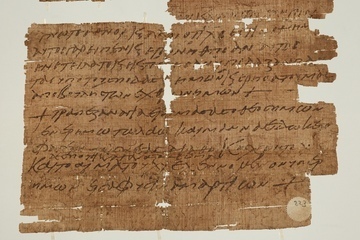
A Greek papyrus dating back some 1,500 years from an ancient Egyptian city refers to Jesus' Last Supper and manna from heaven.
Credit: University of Manchester, John Rylands Research InstituteA 1,500-year-old fragment of Greek papyrus with writing that refers to the biblical Last Supper and "manna from heaven" may be one of the oldest Christian amulets, say researchers.
The fragment was likely folded up and worn inside a locket or pendant as a sort of protective charm, according to Roberta Mazza, who spotted the papyrus while looking through thousands of papyri kept in the library vault at the John Rylands Research Institute at the University of Manchester in the United Kingdom.
"This is an important and unexpected discovery as it's one of the first recorded documents to use magic in the Christian context and the first charm ever found to refer to the Eucharist — the Last Supper — as the manna of the Old Testament," Mazza said in a statement. The fragment likely originated in a town in Egypt
The text on the papyrus is a mix of passages from Psalm 78:23-24 and Matthew 26:28-30, among others, said Mazza, who is a research fellow at the institute. "To this day, Christians use passages from the Bible as protective charms so our amulet marks the start of an important trend in Christianity."
The translated text on the papyrus reads:
"Fear you all who rule over the earth.
Know you nations and peoples that Christ is our God.
For he spoke and they came to being, he commanded and they were created; he put everything under our feet and delivered us from the wish of our enemies.
and delivered us from the wish of our enemies.
Our God prepared a sacred table in the desert for the people and gave manna of the new covenant to eat , the Lord's immortal body and the blood of Christ poured for us in remission of sins."
, the Lord's immortal body and the blood of Christ poured for us in remission of sins."
People of the time believed such passages had magical powers, Mazza told Live Science. Supporting that idea, creases can be seen on the fragment, Mazza said, suggesting the papyrus was folded into a rectangular packet measuring 3 by 10.5 centimeters (1.2 by 4.1 inches), and either placed into a box at home or worn around a person's neck.
3 by 10.5 centimeters (1.2 by 4.1 inches), and either placed into a box at home or worn around a person's neck.

[image error] The ancient amulet, which consisted of a mix of biblical passages, was written on the back of a receipt for payment of a grain tax.
The ancient amulet, which consisted of a mix of biblical passages, was written on the back of a receipt for payment of a grain tax.
Credit: University of Manchester, John Rylands Research Institute
View full size imageThe amulet was written on the back of a receipt that seems to be for payment of a grain tax. The nearly illegible text refers to a tax collector from the village of Tertembuthis, located in the countryside of Hermoupolis, an ancient city in what is now the Egyptian town of el-Ashmunein.
"The text says that the receipt was released in the village of Tertembuthis. Therefore we may reasonably guess that the person who re-used the back for writing the amulet was from that same village or the region nearby, although we cannot exclude other hypotheses," Mazza told Live Science.
Carbon analysis dates the fragment to between 574 and 660, Mazza said. And while the creator knew the Bible, he or she made plenty of mistakes. "Some words are misspelled and others are in the wrong order," Mazza said in the statement. "This suggests that he was writing by heart rather than copying it."
The discovery, which Mazza presented this week at an international conference on papyri at the university's research institute, reveals that Christians adopted an ancient Egyptian practice of wearing such charms to ward off danger.
"This practice is not very far from nowadays use to wear necklaces with the cross or images of Jesus, Mary, or the saints, for protection," Mazza said. "In many Catholic churches nowadays believers are given holy pictures of the saints with a prayer on the back that you can bring along again for protection."
Mazza will submit a paper on the discovery for publication to Zeitschrift für Papyrologie und Epigraphik.
Live Science

A Greek papyrus dating back some 1,500 years from an ancient Egyptian city refers to Jesus' Last Supper and manna from heaven.
Credit: University of Manchester, John Rylands Research InstituteA 1,500-year-old fragment of Greek papyrus with writing that refers to the biblical Last Supper and "manna from heaven" may be one of the oldest Christian amulets, say researchers.
The fragment was likely folded up and worn inside a locket or pendant as a sort of protective charm, according to Roberta Mazza, who spotted the papyrus while looking through thousands of papyri kept in the library vault at the John Rylands Research Institute at the University of Manchester in the United Kingdom.
"This is an important and unexpected discovery as it's one of the first recorded documents to use magic in the Christian context and the first charm ever found to refer to the Eucharist — the Last Supper — as the manna of the Old Testament," Mazza said in a statement. The fragment likely originated in a town in Egypt
The text on the papyrus is a mix of passages from Psalm 78:23-24 and Matthew 26:28-30, among others, said Mazza, who is a research fellow at the institute. "To this day, Christians use passages from the Bible as protective charms so our amulet marks the start of an important trend in Christianity."
The translated text on the papyrus reads:
"Fear you all who rule over the earth.
Know you nations and peoples that Christ is our God.
For he spoke and they came to being, he commanded and they were created; he put everything under our feet
 and delivered us from the wish of our enemies.
and delivered us from the wish of our enemies.Our God prepared a sacred table in the desert for the people and gave manna of the new covenant to eat
 , the Lord's immortal body and the blood of Christ poured for us in remission of sins."
, the Lord's immortal body and the blood of Christ poured for us in remission of sins."People of the time believed such passages had magical powers, Mazza told Live Science. Supporting that idea, creases can be seen on the fragment, Mazza said, suggesting the papyrus was folded into a rectangular packet measuring
 3 by 10.5 centimeters (1.2 by 4.1 inches), and either placed into a box at home or worn around a person's neck.
3 by 10.5 centimeters (1.2 by 4.1 inches), and either placed into a box at home or worn around a person's neck.
[image error]
 The ancient amulet, which consisted of a mix of biblical passages, was written on the back of a receipt for payment of a grain tax.
The ancient amulet, which consisted of a mix of biblical passages, was written on the back of a receipt for payment of a grain tax.Credit: University of Manchester, John Rylands Research Institute
View full size imageThe amulet was written on the back of a receipt that seems to be for payment of a grain tax. The nearly illegible text refers to a tax collector from the village of Tertembuthis, located in the countryside of Hermoupolis, an ancient city in what is now the Egyptian town of el-Ashmunein.
"The text says that the receipt was released in the village of Tertembuthis. Therefore we may reasonably guess that the person who re-used the back for writing the amulet was from that same village or the region nearby, although we cannot exclude other hypotheses," Mazza told Live Science.
Carbon analysis dates the fragment to between 574 and 660, Mazza said. And while the creator knew the Bible, he or she made plenty of mistakes. "Some words are misspelled and others are in the wrong order," Mazza said in the statement. "This suggests that he was writing by heart rather than copying it."
The discovery, which Mazza presented this week at an international conference on papyri at the university's research institute, reveals that Christians adopted an ancient Egyptian practice of wearing such charms to ward off danger.
"This practice is not very far from nowadays use to wear necklaces with the cross or images of Jesus, Mary, or the saints, for protection," Mazza said. "In many Catholic churches nowadays believers are given holy pictures of the saints with a prayer on the back that you can bring along again for protection."
Mazza will submit a paper on the discovery for publication to Zeitschrift für Papyrologie und Epigraphik.
Live Science

Published on September 08, 2014 14:08
3,000-Year-Old Golden Bowl Hides a Grisly Archaeological Tale
By Megan Gannon,
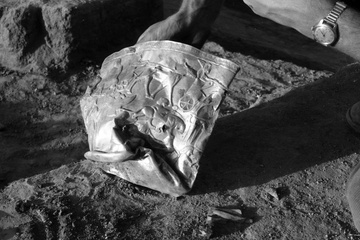 The flattened golden bowl found at Hasanlu in 1958.
The flattened golden bowl found at Hasanlu in 1958.
Credit: Antiquity Publications Ltd.
In 1958, archaeologists were digging through the ruins of a burned Iron Age citadel called Hasanlu in northwestern Iran when they pulled a spectacular, albeit crushed, golden bowl from the layers of destruction.
The 3,000-year-old bowl became an object of fascination once word got to the press. The next year, it graced the pages of Life magazine in a full-color spread alongside an article about the discoveries at Hasanlu.
But the story behind the prized find is less glossy. The bowl was uncovered just beyond the fingertips of a dead soldier and two of his comrades, who were crushed under bricks and burned building material around 800 B.C. Scholars have debated whether these three men were defenders of the citadel or enemy invaders running off with looted treasures. A new interpretation suggests the soldiers were no heroes
Hasanlu is sometimes described as the Pompeii of the ancient Near East, because of its so-called "burn layer," which contains more than 200 bodies preserved in ash and rubble, explained Michael Danti, an archaeologist at Boston University. The archaeological evidence provides a rather disturbing snapshot of the closing hours of the siege of the citadel. [Preserved Pompeii: See Images of a City in Ash]
Located on the shores of Lake Urmia, Hasanlu seems to have been first occupied about 8,000 years ago. But by the ninth or 10th century B.C., there was a bustling, fortified town at the site.
Within the town's walls were houses, treasuries, horse stables, military arsenals and temples, many of which had towers or multiple stories. The mudbrick architecture likely resembled the adobe buildings of the American Southwest, but many roofs, floors and structural supports at Hasanlu consisted of timber and reed matting — all of which would have been tinder in a blaze, Danti said.
Other central details about life at Hasanlu are less clear. Archaeologists don't know the ethnicity of the people who lived there or what language they spoke.
"Despite the really rich material record, they didn't really find any indigenous writing at all," Danti said.
The burn layer at Hasanlu suggests a surprise attack destroyed the citadel. Archaeologists who excavated the site in the 1950s, '60s and '70s found corpses that were beheaded and others that were missing hands. Danti said he has seen a fairly clear example of a person who was cut in half. [8 Other Grisly Archaeological Discoveries]
"The students that were working there would have nightmares at night, because they were spending hours and hours out there excavating murder victims," Danti told Live Science. Many of the victims were women and children. And in mass graves on top of the burned layer, excavators found the remains of people who tended to be very young or old and seemed to have suffered fatal, blunt-force trauma head wounds. These victims likely survived the initial attack only to be killed when their captors realized they would be of little use as slaves, Danti said.
"This was warfare that was designed to wipe out people's identity and terrify people into submission," Danti said.
Danti, who has been piecing together a history of the site from excavation archives as part of a larger, more daunting project, published a study on Hasanlu in the September 2014 issue of the journal Antiquity. The site was primarily excavated between 1956 and 1977 under the direction of Robert H. Dyson, who led a team from the University of Pennsylvania, the Metropolitan Museum of Art in New York and the Archaeological Service of Iran. Because of security pressures and the overwhelming amount of material found at the site, the pace of their work was often hurried, and their record-keeping methods were not always meticulous. Some artifacts were pulled from the ground before they were documented or photographed in situ. There are no photographs of the gold bowl before it was taken out of the ground, for example.
In revisiting Hasanlu, Danti has taken a closer look at the three warriors. He said it seems likely they were climbing up a wooden staircase inside of a home when the building collapsed. The men fell through what was probably a waste-disposal chute and were buried by debris. Besides the gold bowl, there are other treasures scattered around their bodies, including textiles, fancy armored belts, metal vessels and delicately carved cylinder seals.
The outfits and weapons of the warriors look like standardized military equipment, Danti said. The men wore crested helmets with earflaps, and they carried spiked maces. They appear to have been well-prepared for battle.
"I doubt these men were rescuing a valued bowl and many other fine objects with little hope of egress as the citadel burned and its remaining occupants were slaughtered or taken captive," Danti wrote in his conclusion.
Danti's interpretation supports a hypothesis that the warriors hailed from the Urartu kingdom that grew out of an area in modern-day Turkey. Historical texts indicate the ancient Urartu kingdom was expanding into the region around Hasanlu during the Iron Age through a brutal military campaign. Sometime after the citadel was abandoned, an Urartian fortification wall was built on top of the ruins of Hasanlu.
Still, Danti said he hopes other researchers will test his hypothesis and perform bioarchaeological analyses on the skeletons of both the warriors and the slain people who lived at Hasanlu. Diet and drinking water leave telltale biomarkers in a person's skeleton, and a bone analysis could help confirm where the warriors came from, and whether they died trying to protect or steal the town's riches.
Live Science

 The flattened golden bowl found at Hasanlu in 1958.
The flattened golden bowl found at Hasanlu in 1958.Credit: Antiquity Publications Ltd.
In 1958, archaeologists were digging through the ruins of a burned Iron Age citadel called Hasanlu in northwestern Iran when they pulled a spectacular, albeit crushed, golden bowl from the layers of destruction.
The 3,000-year-old bowl became an object of fascination once word got to the press. The next year, it graced the pages of Life magazine in a full-color spread alongside an article about the discoveries at Hasanlu.
But the story behind the prized find is less glossy. The bowl was uncovered just beyond the fingertips of a dead soldier and two of his comrades, who were crushed under bricks and burned building material around 800 B.C. Scholars have debated whether these three men were defenders of the citadel or enemy invaders running off with looted treasures. A new interpretation suggests the soldiers were no heroes
Hasanlu is sometimes described as the Pompeii of the ancient Near East, because of its so-called "burn layer," which contains more than 200 bodies preserved in ash and rubble, explained Michael Danti, an archaeologist at Boston University. The archaeological evidence provides a rather disturbing snapshot of the closing hours of the siege of the citadel. [Preserved Pompeii: See Images of a City in Ash]
Located on the shores of Lake Urmia, Hasanlu seems to have been first occupied about 8,000 years ago. But by the ninth or 10th century B.C., there was a bustling, fortified town at the site.
Within the town's walls were houses, treasuries, horse stables, military arsenals and temples, many of which had towers or multiple stories. The mudbrick architecture likely resembled the adobe buildings of the American Southwest, but many roofs, floors and structural supports at Hasanlu consisted of timber and reed matting — all of which would have been tinder in a blaze, Danti said.
Other central details about life at Hasanlu are less clear. Archaeologists don't know the ethnicity of the people who lived there or what language they spoke.
"Despite the really rich material record, they didn't really find any indigenous writing at all," Danti said.
The burn layer at Hasanlu suggests a surprise attack destroyed the citadel. Archaeologists who excavated the site in the 1950s, '60s and '70s found corpses that were beheaded and others that were missing hands. Danti said he has seen a fairly clear example of a person who was cut in half. [8 Other Grisly Archaeological Discoveries]
"The students that were working there would have nightmares at night, because they were spending hours and hours out there excavating murder victims," Danti told Live Science. Many of the victims were women and children. And in mass graves on top of the burned layer, excavators found the remains of people who tended to be very young or old and seemed to have suffered fatal, blunt-force trauma head wounds. These victims likely survived the initial attack only to be killed when their captors realized they would be of little use as slaves, Danti said.
"This was warfare that was designed to wipe out people's identity and terrify people into submission," Danti said.
Danti, who has been piecing together a history of the site from excavation archives as part of a larger, more daunting project, published a study on Hasanlu in the September 2014 issue of the journal Antiquity. The site was primarily excavated between 1956 and 1977 under the direction of Robert H. Dyson, who led a team from the University of Pennsylvania, the Metropolitan Museum of Art in New York and the Archaeological Service of Iran. Because of security pressures and the overwhelming amount of material found at the site, the pace of their work was often hurried, and their record-keeping methods were not always meticulous. Some artifacts were pulled from the ground before they were documented or photographed in situ. There are no photographs of the gold bowl before it was taken out of the ground, for example.
In revisiting Hasanlu, Danti has taken a closer look at the three warriors. He said it seems likely they were climbing up a wooden staircase inside of a home when the building collapsed. The men fell through what was probably a waste-disposal chute and were buried by debris. Besides the gold bowl, there are other treasures scattered around their bodies, including textiles, fancy armored belts, metal vessels and delicately carved cylinder seals.
The outfits and weapons of the warriors look like standardized military equipment, Danti said. The men wore crested helmets with earflaps, and they carried spiked maces. They appear to have been well-prepared for battle.
"I doubt these men were rescuing a valued bowl and many other fine objects with little hope of egress as the citadel burned and its remaining occupants were slaughtered or taken captive," Danti wrote in his conclusion.
Danti's interpretation supports a hypothesis that the warriors hailed from the Urartu kingdom that grew out of an area in modern-day Turkey. Historical texts indicate the ancient Urartu kingdom was expanding into the region around Hasanlu during the Iron Age through a brutal military campaign. Sometime after the citadel was abandoned, an Urartian fortification wall was built on top of the ruins of Hasanlu.
Still, Danti said he hopes other researchers will test his hypothesis and perform bioarchaeological analyses on the skeletons of both the warriors and the slain people who lived at Hasanlu. Diet and drinking water leave telltale biomarkers in a person's skeleton, and a bone analysis could help confirm where the warriors came from, and whether they died trying to protect or steal the town's riches.
Live Science

Published on September 08, 2014 14:03
Female Sculptures Guard Mysterious Tomb in Greece
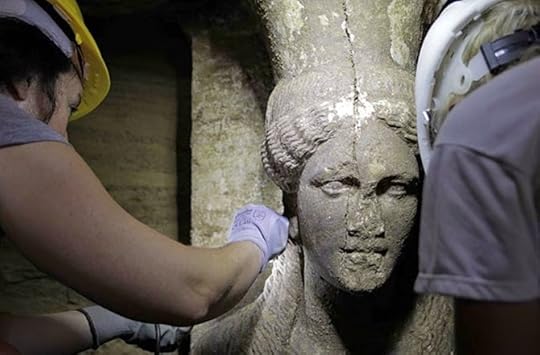 by Rossella Lorenzi
by Rossella Lorenzi Greek archaeologists made another amazing find on Saturday as they unearthed two finely sculpted Caryatids -- female sculptures -- inside a mysterious tomb from the time of Alexander the Great, in Amphipolis, about 65 miles from Thessaloniki.
Carved from marble with traces of blue-and-red paint, the Caryatids were found when a team of archaeologists, led by Katerina Peristeri, removed sandy soil in front of a sealing wall.
PHOTOS: Female Sculptures Revealed in Greek Tomb
The sculptures stood between two marble pillars that supported a beam. Wearing a sleeved tunic and earrings, they feature long, thick hair covering their shoulders. While the face of one Caryatid survives almost intact, the other is missing.
“The right arm of the western Caryatid and the left arm of the eastern one are both outstretched, as if to symbolically prevent anyone attempting to enter the grave,” the Culture Ministry said in a statement.
Earlier, the team discovered two headless, wingless sphinxes guarding the tomb’s entrance.
“The presence of a second sealing wall with Caryatids supports the idea this is an outstanding monument of particular importance,” the ministry statement said.
Mosaics Revealed at Alexander the Great-Era Tomb
Pieces of the sculptures, such as parts of palm and finger fragments, were recovered from the soil.
Also, a perfectly preserved rectangular marble block, measuring 14 feet long and 3 feet wide, was unearthed at the bottom of the vault.
On the underside of the large block, the archaeologists found blue-, red- and yellow-painted decoration, representing panels with rosettes in the center.
Other rosettes were found earlier, embossed on a marble beam.
PHOTOS: Greek Tomb Shows Signs of Looting
According to Andrew Chugg, author of “The Quest for the Tomb of Alexander the Great,” the rosettes at Amphipolis strongly resemble those decorating the edge bands of the gold coffin from the tomb of Philip II, Alexander the Great’s father.
“It’s looking as though a rosette is a badge of the occupant,” Chugg told Discovery News.
At the moment, Chugg considers Olympia, Alexander’s mother, as the person most likely buried in the magnificent tomb.
“The Caryatids are a truly spectacular find. The fact that we now have a second pair of sculpted female guardians is of course boosting the case for this being the tomb of an important queen,” Chugg said.
He noted that the sphinxes guarding the tomb entrance were a symbol of Macedonian queens from the late fourth century B.C.
Toxic Wine Might Have Killed Alexander the Great
“Sphinxes are not particularly common in high-status Macedonian tombs of this era, but, significantly, sphinxes were prominent parts of the decoration of two thrones found in the late 4th century-B.C. tombs of two Macedonian queens in the royal cemetery at Aegae, modern Vergina,” Chugg wrote in the url=http://greece.greekreporter.com/2014/... Reporter.
One of the thrones decorated with sphinxes was attributed to Eurydice I, Alexander the Great’s grandmother.
Historical records point to two Macedonian queens who died at Amphipolis in the last quarter of the fourth century B.C.: Olympias and Roxane, Alexander’s wife.
“Olympias is looking like a very strong candidate now, with Roxane in second place and a combination of the two is not unlikely,” Chugg concluded.
Discovery News

Published on September 08, 2014 13:51
My review of Alex the Mutt by Brenda Perlin

The author shares her experiences with dog adoptions and the plight of unwanted animals in shelters. Ms. Perlin reminiscences about her relationship with her dog, Alex, revealing emotions that dog lovers can relate to. Also commendable is the author’s request that people find dogs through rescue shelters instead of frequenting puppy mills. A delightful, heartwarming story.
Amazon Purchase Link

Published on September 08, 2014 13:40




